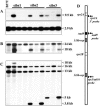A mitochondrial mutator system in maize
- PMID: 15681663
- PMCID: PMC1065377
- DOI: 10.1104/pp.104.053611
A mitochondrial mutator system in maize
Abstract
The P2 line of maize (Zea mays) is characterized by mitochondrial genome destabilization, initiated by recessive nuclear mutations. These alleles alter copy number control of mitochondrial subgenomes and disrupt normal transfer of mitochondrial genomic components to progeny, resulting in differences in mitochondrial DNA profiles among sibling plants and between parents and progeny. The mitochondrial DNA changes are often associated with variably defective phenotypes, reflecting depletion of essential mitochondrial genes. The P2 nuclear genotype can be considered a natural mutagenesis system for maize mitochondria. It dramatically accelerates mitochondrial genomic divergence by increasing low copy-number subgenomes, by rapidly amplifying aberrant recombination products, and by causing the random loss of normal components of the mitochondrial genomes.
Figures








Similar articles
-
Small kernel 1 encodes a pentatricopeptide repeat protein required for mitochondrial nad7 transcript editing and seed development in maize (Zea mays) and rice (Oryza sativa).Plant J. 2014 Sep;79(5):797-809. doi: 10.1111/tpj.12584. Epub 2014 Jul 28. Plant J. 2014. PMID: 24923534
-
Selective DNA amplification regulates transcript levels in plant mitochondria.Curr Genet. 1995 Jul;28(2):113-21. doi: 10.1007/BF00315776. Curr Genet. 1995. PMID: 8590461
-
Effects of reduced chloroplast gene copy number on chloroplast gene expression in maize.Plant Physiol. 2012 Nov;160(3):1420-31. doi: 10.1104/pp.112.204198. Epub 2012 Sep 13. Plant Physiol. 2012. PMID: 22977281 Free PMC article.
-
The maize mitochondrial genome: dynamic, yet functional.Trends Genet. 1995 Jun;11(6):228-35. doi: 10.1016/s0168-9525(00)89056-3. Trends Genet. 1995. PMID: 7638905 Review.
-
Paramutation in maize and related allelic interactions.Curr Top Microbiol Immunol. 1995;197:121-41. doi: 10.1007/978-3-642-79145-1_9. Curr Top Microbiol Immunol. 1995. PMID: 7493488 Review. No abstract available.
Cited by
-
The Mosaic Mutants of Cucumber: A Method to Produce Knock-Downs of Mitochondrial Transcripts.G3 (Bethesda). 2015 Apr 14;5(6):1211-21. doi: 10.1534/g3.115.017053. G3 (Bethesda). 2015. PMID: 25873637 Free PMC article.
-
Transcriptome Analyses of Mosaic (MSC) Mitochondrial Mutants of Cucumber in a Highly Inbred Nuclear Background.G3 (Bethesda). 2018 Mar 2;8(3):953-965. doi: 10.1534/g3.117.300321. G3 (Bethesda). 2018. PMID: 29330162 Free PMC article.
-
Characterization of a novel thermosensitive restorer of fertility for cytoplasmic male sterility in maize.Genetics. 2009 May;182(1):91-103. doi: 10.1534/genetics.108.099895. Epub 2009 Mar 2. Genetics. 2009. PMID: 19255365 Free PMC article.
-
Dominant male sterility in sorghum: effect of nuclear background on inheritance of tissue-culture-induced mutation.Theor Appl Genet. 2005 Nov;111(7):1377-84. doi: 10.1007/s00122-005-0069-1. Epub 2005 Nov 15. Theor Appl Genet. 2005. PMID: 16205908
-
The rice mitochondrial genomes and their variations.Plant Physiol. 2006 Feb;140(2):401-10. doi: 10.1104/pp.105.070060. Epub 2005 Dec 29. Plant Physiol. 2006. PMID: 16384910 Free PMC article.
References
-
- Bellaoui M, Martin-Canadell A, Pelletier G, Budar F (1998) Low-copy-number molecules are produced by recombination, actively maintained and can be amplified in the mitochondrial genome of Brassicaceae: relationship to reversion of the male sterile phenotype in some cybrids. Mol Gen Genet 257: 177–185 - PubMed
-
- Brown WL, Duvick DN (1958) An extreme nuclear-cytoplasmic interaction. Maize Genet Coop News Lett 32: 120–121
-
- Chomczynski P, Sacchi N (1987) Single-step method of RNA isolation by acid guanidinium thiocyanate-phenol-chloroform extraction. Anal Biochem 162: 156–159 - PubMed
Publication types
MeSH terms
Substances
LinkOut - more resources
Full Text Sources

